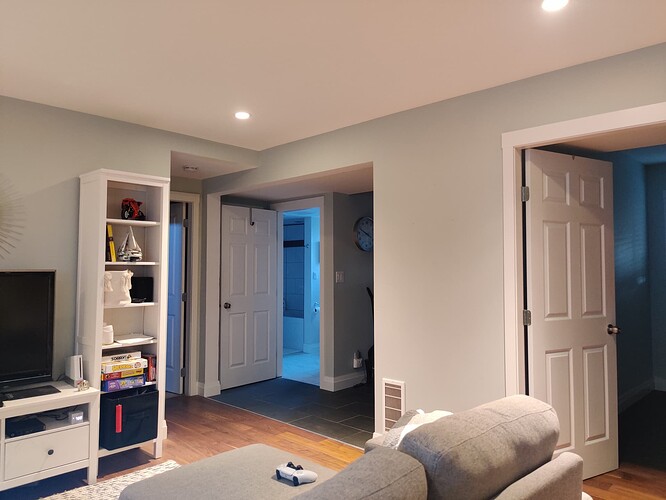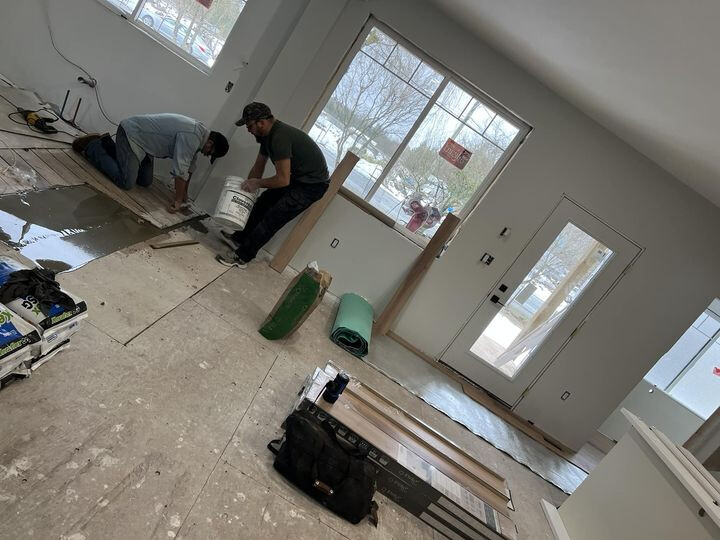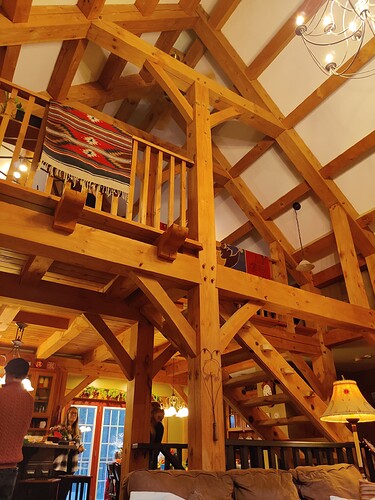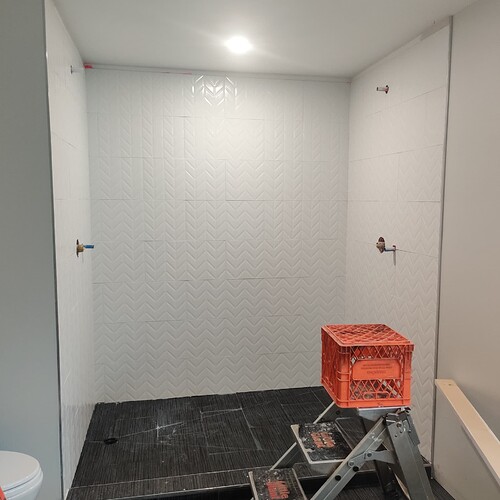The skim coat gives the walls a glass hardened surface to withstand wear and tear aspect - bumping furniture against it etc. Boarded walls are a tad more vulnerable if you have young kids or dogs in the house - Think of the plaster skim as akin to a hard durable gloss paint you would apply to a front door instead of applying an emulsion soft type of paint in the same scenario.
but it’s so much extra work, even moreso than just having to go back and fix a dent in the drywall and a touch-up of paint? Anyways…when my basement was being done I hired a crew to come in and board it, and someone I knew was rediculously good with a trowel so he did the taping for me. I had to do all of the sanding between coats though.
I bought my house from a guy who flipped houses, who bought it from a family who had some hoarding issues. we were planning a lipstick makeover on the basement, but when we started poking around that’s when we knew it was a full gut. 5 weeks turned into 3.5 months. Fortunately I was able to get most of my expensive materials from construction wastage on huge projects (gotta love that 10% extra theory). like my flooring and kitchen and tile. All told it cost me $25k, should have been $80-90k.
I once tried to understand why professionals choose one way or the other. When I asked my brother IL who runs his own home building company, why they don’t skin coat the whole room over the plasterboard and he basically laughed in my face, similar to your reaction.
When I asked a plasterer who skim coat plastered my loft conversion in the UK way, he basically shrugged his shoulders as if he wasn’t aware there was an alternative.
Thank you for taking the time ![]()
![]()
I’d rather paint than paper if possible.
Are Canadian houses mostly timber frame construction? I have always wondered whether it was because of the weather that UK construction industry is so set in its ways of brick and block construction. I’ve never understand why there isn’t variety. Like @klopptimist mentioned earlier.
Edit: I should say timber frame and clad type houses, as opposed to brick and block.
I dunno. like I said, my brother and dad are the builders in the family. I chose a different path.
my brother’s house is actually a large addition onto an existing home, here they’re having to match the two floors so they can make a seamless transition between 60yo shiplap floors (left) and new build. He had to calculate the drop from the existing floor to determine his basement foundation height and have it match up by the time he had the second level subfloor installed. a bit of math there
depends on where you live, as to what type of home you can build. with the abundance of wood here (and being an earthquake zone) most houses are timberframe. lots of brick used back east in the older areas of Ontario, but I’m pretty sure it’s just a brick facade behind timberframe. due to being in a temperate rainforest here, most homes are being built now with Hardie board or vinyl siding or a combination of both. My home was originally sheathed in 1" thick crosscuts of cedar, but as it’s started to wear our we’re transitioning it to Hardie.
I built a detached house many years ago and was determined everything was done above specification… I decided to have the whole house rendered with a sand/cement and epoxy resin mix so that not only would it withstand a nuclear bomb attack :0) - but the main reason was it would last a couple of centuries without cracking or be vulnerable to water ingress which is common with some types of rendering. Handed the entire job over a father and son combination that were quite diligent and had an unhurried approach in their work… Anyway almost 4months later until completion, and they did what can only described as an absolutely excellent job…
Another few months all exterior rendering had been painted with a 4coat system, ending up with a Diamond Gloss grade finish. When the sun shines on the paintwork, it was actually reflecting the rays… Anyway, I was so pleased with the appearance - That was until 12months later walking down the road, and a big van passed by with a F—ing big mural transfer on both sides of it - I thought to myself, that picture looks familiar - It was only the plasters van that had done my rendering wasn’t it - He had waited for his work to be painted then sent a professional photographer out to the house to take the snap - F—ing hell… I rang him that night and asked about it - he told me he went half payment with the painter to get these mural posters printed…! Not sure about you… but if you have a house in Liverpool, what you most certainly don’t do… is have your house advertised on the side of 4vans in total driving about daily for to give all the burglars in the world and its dog ideas to come and find your location…
Anyway, touch wood, 20yrs later, never got a visit from any thieves in the night :0)
You need to understand how much newer our housing stock is than the UK or Europe. In my neighbourhood, the ‘old’ houses are post-war, and are largely being knocked down in favour of much larger new houses. The really old houses are mostly just approaching one hundred years old. A hundred years ago, the population of the Ottawa area was around 100,000.
North America just wasn’t and isn’t built with permanence in mind, for better or worse. The scale of investment in the time frames has largely precluded the quality of construction normally seen in Europe historically. The log building at my original family homestead in the area was never meant to be in use 150 years later, it was meant to serve as passable shelter until the masons could come and build a proper stone house.
if I go back to my Ukrainian ancestry settling in Vaigreville, Alberta and look at the home my grandmother was born in… would be considered a shanty nowadays. back then it was a working farmhome but has since all but fallen down. would have been built about 100yrs ago
My dad’s side had a log home about 20min from here on acreage which has been handed over to the Heritage Society. Still has working post-war appliances in it when the wood stove was removed in favor of electricity for cooking. I loved that home it was so cozy. even had a root cellar for my great aunt’s garden canning.
Interesting that the further West you get, the more you see that the immigrants realised what could be done with wood. NYC mostly brick as an example. Well, and concrete and steel obviously.
I think what you are seeing there is actually the age of the city. The big centers of the eastern seaboard are the oldest urban centers. All those NYC brownstones replaced wooden structures.
yes. and the bent/twisted hardwood trees of those old areas aren’t condusive to timberframe housing like the long straight grains of the SPF trees in the boreal forests of Canada.
the other day I was eyeballing up some trees with my brother when we were in an older grove of second-growth trees, and he figured one particular large one would have been worth $50k in clear lumber alone in the bottom 80ft. Not a branch in that section, about 5-1/2feet across at 6ft across. prob 200ft tall.
Boggles my mind that so much of the forest we see now has already been logged once. some MASSIVE old growth stumps still visible today in some areas like flooded lakes where the wood has been preserved in the water.
Not entirely true - until circa 1900 the dominant tree of the Appalachians was the American chestnut. They grow straight and as tall as 30 meters. Great wood for construction for the early settlers, works well, good water resistance too. You still find 200 year old barns in fine shape that use chestnut timber frames. But the chestnut blight of 1900 or so onward has annihilated the chestnut trees. The modern Appalachian forest is a mix of transitional species and the hardwood types you are referring to, and looks nothing like it did 200 years ago - with only a tiny fraction of the natural food production.
sure, but we’re talking about the transition from stone/brick to timberframe. as an example, this home which was built by my inlaws in Tavistock area was all softwood, harvested and milled locally…
Gorgeous - but what I am saying is that 150 years ago, in most of Eastern North America you could readily do timberframes with an easily worked hardwood. That is gone now, and as you noted, there aren’t obvious species replacements. So timberframe just dropped out of the repertoire for most of the continent.
Giant Redwood
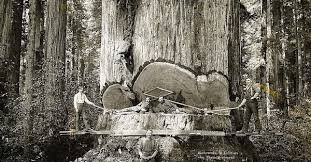
those are protected trees now, as are the remaining old-growth up here.
My dad grew up about an hour from here.
